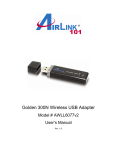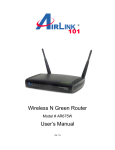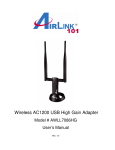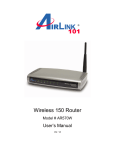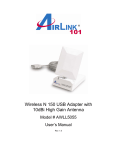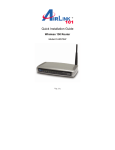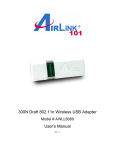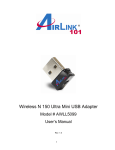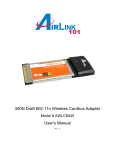Download AirLink Wireless N 150 PCI
Transcript
Wireless N 150 PCI Adapter Model # AWLH5075 User’s Manual Rev. 1.0 Table of Contents 1. Introduction ..............................................................................................................................2 1.1 Package Contents................................................................................................................2 1.2 Features...............................................................................................................................2 2. Install the Wireless PCI Adapter ..............................................................................................3 3. Connect to Wireless Network...................................................................................................9 4. Configure Wireless Monitor...................................................................................................11 4.1 Profile ...............................................................................................................................13 4.2 Network ............................................................................................................................14 4.3 Advanced ..........................................................................................................................17 4.4 Statistics............................................................................................................................18 4.5 WMM ...............................................................................................................................18 4.6 WPS (Easy Setup Button) ................................................................................................20 4.7 CCX ..................................................................................................................................24 4.8 About ................................................................................................................................25 Troubleshooting..........................................................................................................................26 Appendix A - Specification ........................................................................................................27 Appendix B - Federal Communication Commission Interference Statement ...........................28 Technical Support.......................................................................................................................29 1 1. Introduction Congratulations on your purchase of the Wireless N 150 PCI Adapter. Its high bandwidth combined with extended wireless coverage delivers fast and reliable connection for all of your networking applications especially when used with other Airlink101® Wireless N products. A full range of security features WPA-PSK, WPA2-PSK and CCX provide the highest level of wireless network security. The bundled Wireless Monitor utility allows you to set up the adapter with an easy-to-use user interface. Best of all the Wireless N 150 PCI Adapter works with other 802.11 b /g / n network devices which ensures the compatibility with your existing wireless products. 1.1 Package Contents Before you begin the installation, please check the items of your package. The package should include the following items: • • • • Wireless N 150 PCI Adapter Antenna Quick Installation Guide Installation CD (Driver/Utility/Manual) 1.2 Features • • • • • • • Highest wireless data rate of up to 150Mbps* with Wireless N technology Stronger signal strength increases the reliability and stability of your wireless connections Wi-Fi Protected Access (WPA2 and WPA) support provides full protection for your wireless connection Easy Setup Button for easy connection to the existing wireless network Great for environments with higher wireless data traffic requirements Fully backward-compatible with 802.11b/g devices Works best with other AirLink101® Wireless N products 2 2. Install the Wireless PCI Adapter Step 1.1 SWITCH THE COMPUTER OFF, remove the cover and insert the wireless PCI adapter into an available PCI slot of your computer. Step 1.2 Fasten the provided antenna to the antenna connector on the wireless PCI adapter. Step 1.3 Switch on the computer. Step 1.4 Click Cancel when you see the Found New Hardware Wizard. Windows 7 users: Go to Step 1.5 when you see this message. Windows Vista users: Click Cancel and go to Step 1.5. Windows XP users: Click Cancel and go to Step 1.5. 3 Step 1.5 Insert the Installation CD in the CD drive. When the autorun screen pops up, click Install Utility and Driver. Windows 7 and Vista Users: When you get warning message(s), make sure that you click Allow to continue with the installation of the driver software. 4 Step 1.6 Click Next. Step 1.7 Click Next to start installing the software. 5 For Windows 7 and Vista users: Click Install this driver software anyway. For Windows XP users: click Continue Anyway at the Windows Logo. 6 Step 1.8 Click Finish. 7 Step 1.9 You will see the Airlink101 Wireless Monitor pops up. Congratulations! The Wireless N 150 PCI Adapter has now been successfully installed on your computer. 8 3. Connect to Wireless Network This section describes how to connect your wireless adapter to a wireless network. Note: If the Airlink101 Wireless Monitor does not open on your desktop, you can open the Airlink101 Wireless Monitor utility by double clicking on the Airlink101 Wireless Monitor Utility icon in the system tray at the bottom right-hand corner of your screen. If the icon does not appear in the system tray, go to Start → Programs → Airlink101 → Airlink101 Wireless Monitor. Step 1 Click on Network, you will see the available wireless networks in your environment. Select the wireless network you want to connect to and click on Connect. Step 2 Type in the network key of your wireless network and click OK. 9 Step 3 After the adapter connects to the wireless network successfully, a blue triangle will appear at the front of your wireless network. 10 4. Configure Wireless Monitor This section describes the various functions of the Wireless Monitor that you can configure. Some general functions of this utility will be described here, and the features of each tab will be described in the following sections. Top Menu: Click on the buttons to go to the specific settings/information you need to change/view. RF ON/OFF: Click on RF ON/OFF to switch on/off the wireless connection. Click on the down/up arrow on the right hand side to display or hide the Status. Status: Display the SSID and BSSID of connected wireless access point or wireless device (displayed as SSID<-> BSSID as shown in above picture. If there’s no active connection currently, ‘Disconnected’ will be displayed here. 11 Extra Info: Displays the link status (‘Link is up’ or Link is down’, and the radio transmitting power of your network card. Channel: Displays the radio channel being used now. Authentication: Shows the authentication mode that access point or wireless device uses. If the wireless access point does not require authentication, you’ll see ‘Unknown’ displayed here. Encryption: Shows the encryption method that access point or wireless device uses. If the wireless access point does not enable encryption, you’ll see ‘None’ displayed here. Network Type: Shows the type of wireless connection. If it’s a wireless access point, ‘Infrastructure’ will be displayed here; if it’s a computer or network device, ‘AdHoc’ will be displayed here. Link Speed: Displays the link speed of data transmitting (Tx, in Mbps) and receiving (Rx, in Mbps). Link speed is the maximum available data transfer speed of the wireless connection. It depends on the radio signal quality of wireless connection. Throughput: Displays the rate of data transmitting (Tx, in Kbps) and receiving (Rx, in Kbps). Link Quality: Displays link quality (radio signal quality). When the link quality is better, the wireless link speed will be better, too. Link quality is displayed by percentage and a descriptive word (Good, normal, weak, and low). Signal Strength 1: Displays the radio signal strength of antenna. 12 4.1 Profile The Profile tab lists the current profiles and allows you to manage and create new profiles. The Profile List box lists all the profiles that you’ve created for your networks. You can create a profile for a wireless network you use very often at certain area, such as the wireless network at your home or office so that you can interchange connections more easily. You will need to manually add in these profiles. To modify an existing profile, select the profile from the Profile List box and click Edit. To create a new profile, click Add. Enter a Profile Name and SSID. Enter the encryption settings for the profile. Click OK to save the changes. If you want to create a profile for an existing wireless network, please refer to Section 4.2, Step 1 to 4. To delete a profile, select the profile you want to delete, and click Delete. To export all profiles, click Export and select a destination folder from the popup window to export all profiles. To import profiles, click Import and select a profile you wish to import from your file directory and click OK to start importing your profiles. To activate a profile, select the profile you wish to connect and click Activate. 13 4.2 Network The Network tab lists all of the available networks that the network card detects in your area. Rescan: Clicking Rescan will refresh the network list. Connect: To connect to a wireless network, please refer to Step 1 to 3 in Chapter 3. Add to Profile: To add a network to profile, please follow the instructions below. Step 1 Under Network tab, select a desired network, and click Add to Profile. Step 2 Specify a Profile Name, and configure other settings if needed when the “System Config” box appears below, Click OK. 14 Profile Name: Please give this profile a name, up to 32 alphanumerical Characters and symbols are allowed, but space is not allowed. SSID: The SSID of the wireless access point or wireless device you selected will be displayed here. But if the SSID of access point or wireless device is not available, you have to input it here manually. PSM (Power Saving Mode): Select CAM (constantly awake mode, keeping the wireless radio activity when not transferring data), or PSM (Power saving mode, switching radio off when not transferring data). Network Type: Select network type (‘Ad Hoc’ or ‘Infrastructure’). If you’re adding a profile from an existing access point or wireless device, it’s automatically selected and you don’t have to change it. TX Power: You can select the radio output power of wireless network card. You may not need full radio power if you’re not far from wireless access point, and only use a high setting here if you found that radio reception is bad. If you don’t know which one to use, select ‘Auto’. Preamble: This option is only available when the network type is ‘Ad hoc’. You can select ‘Auto’ or ‘Long Preamble’. Please select ‘Auto’ if you don’t know what it is. RTS Threshold: Check the box and you can set RTS threshold manually here. It is not recommended to modify default setting unless you know what result it will cause. Fragment Threshold: Check the box and you can set fragment threshold manually here. It is not recommended to modify default setting unless you know what result it will cause. Step 3 Enter the security settings of the wireless network you try to connect to. The utility, Wireless Monitor will automatically detect the Authentication and Encryption mode. Click OK. 15 Step 4 Select the profile you just created and click Activate. 16 4.3 Advanced This wireless network card provides several advanced settings for experienced wireless users. You can change these settings to increase data transfer performance, or change operation mode. Wireless mode: Select wireless mode, only 2.4G (single bandwidth) is available here. Enable TX Burst: Check this box to accelerate the data transmit rate. It may not work with all wireless access points and wireless devices. Enable TCP Window Size: Check this box and the configuration utility will adjust TCP window size automatically to get better performance. It should be safe for most of wireless environments, but if you found some problem on data transfer, uncheck this box. Fast Roaming at: Check this box and you can adjust the threshold of when this wireless network card should switch to another wireless access point with better signal quality. Only adjust value when you know what result it will cause. Select Your Country / Region Code: Select the country / region code of the place you’re living. Different country / region has different regulations on wireless devices, and it’s forbidden to use certain channel (radio frequency) in some countries or regions. For instance, only channel 1~11 are allowed in US and Canada. Please select the country and region code according to the place you live. (This option may be disabled for certain countries due to emission safety regulations.) Click Apply to save the new settings. 17 4.4 Statistics The Statistics section gives you information about transmit and receive packet count. Click Reset Counter to reset all counters to zero. 4.5 WMM The AWLH6075, Wireless N PCI Card provides QoS (Quality of Service) function, which can improve the performance of certain network applications, like audio / video streaming, network telephony (VoIP), and others. When you enable WMM (Wi-Fi MultiMedia) function of this network card, you can define the priority of different kinds of data, to give higher priority to applications which require instant responding. Therefore you can improve the performance of certain network applications. 18 WMM Enable: Check this box to enable WMM function. Please click ‘Apply’ button on the right of this check box after you check or uncheck this box, so corresponding settings in this window will be activated or deactivated respectively. WMM - Power Save Enable: Enable WMM power saving mode to save energy and let your battery live longer. AC_BK (Background / Low Priority), AC_BE (Best Effort), AC_VI (Video First), and AC_VO (Voice First): Check one or more options; when the checked type of data is transferring, power saving function will be disabled. Direct Link Setup Enable: Enable or disable direct link setup (DLS) function. This function will greatly improve the data transfer rate between WMM-enabled wireless devices. This function only works when the network card connects to an AP or wireless router with DLS enabled. MAC Address: Input the MAC address of another WMM-enabled wireless device you wish to establish a direct link here, then click ‘Apply’ to add this MAC address to DLS address table. Timeout Value: Input the timeout value of this WMM-enabled direct link wireless device. If the wireless device is not responding after this time, it will be removed from DLS table. Tear Down: If you want to remove a specific wireless device from DLS table, select the device and click this button to remove it. 19 4.6 WPS (Easy Setup Button) WPS is a new and easy way to configure the encryption for your wireless network clients. In order to use it, you need to have a router that supports this feature, like the AR675W Airlink101 Wireless N 300 Green Router or AR570W Wireless N 150 Router. You also need to configure the wireless encryption on the router; you should find the instructions for configuring it in the router User Manual. If your wireless router does not support WPS, you will need to set up the wireless security manually and you can skip this section. We are using the AWLH5075 Wireless N 150 PCI Adapter and AR675W Airlink101 Wireless N 300 Router to illustrate the following setup instructions. Step 1 Open the Airlink101 Wireless Monitor. Click the WPS tab. Choose your configuration method: - For Pin Input method, write down the Pin Code on a piece of paper then click PIN button, continue to Step 2a Pin Code - For Push Button method, click PBC button, or push the Easy Setup Button (WPS Button) on the PCI card for 3 seconds. Continue to Step 3a. 20 WPS Button Step 2a If you selected PIN Input method, go to a computer that is connected to your Wireless Router. Open the browser; enter http://192.168.2.1 into the URL address bar. Note: 192.168.2.1 is the default IP address of AR675W Wireless N Router; you might have a different one for your residential gateway. Please contact your ISP / router’s manufacture for more information. Step 2b Enter admin for both the user name and password and click OK. Step 2c Click on Wireless > WPS on the left menu bar. Make sure the “Disable WPS” is NOT checked. 21 Step 2d Enter the PIN number you just wrote down into the Client PIN Number box and click Start PIN. Continue to Step 4. Step 3a If you selected PBC method, click the Reset/WPS button on the back of the router for 3 seconds. (The WLAN LED will stop blinking while WPS mode is triggered.) Step 4 The Router will now start the handshake with the wireless adapter which will take about 2 minutes. When you see the window similar to the one below, the connection has been established. 22 Note: If you cannot connect successfully with WPS, you need to log in to your router’s configuration page and click on Wireless. Then click WPS. Make sure that Disable WPS box is unchecked, refer to Step 2c. 23 4.7 CCX Enable Cisco Compatible eXtensions. CCX is a wireless feature developed by Cisco used to improve the wireless performance with CCX compatible wireless devices. Check this box if you need to connect to CCX-compatible wireless devices. Enable Radio Measurements: When you’re connecting to CCX-compatible access point, check this box to enable radio measurement function to improve wireless connectivity. Non-Serving Channel Measurements: When you’re connecting to CCX-compatible access point, check this box to enable measurement on unused radio channels to improve wireless connectivity. Limit (ms): Limit the time used for said measurement to a milliseconds certain time. Default value is 250. NetworkEAP: In wireless connection using EAP, a user requests connection to a wireless network through an AP, which then requests the identity of the user and transmits that identity to an authentication server such as RADIUS. Check this box to enable Network EAP function if you need to use this feature. Roaming with RF Parameters: A default set of RF Parameters defined by Cisco are used to set the RF thresholds adopted by the client to decide when to roam. Check this box to enable Roaming with RF Parameters function. Roaming with CAC: The CAC means Call Admission Control. Check this box to enable Roaming with CAC if you need to use this feature. Click Apply to save the settings you have made. 24 4.8 About The About window provides the information about the Wireless Monitor Utility version and the current driver version. 25 Troubleshooting 1. If you cannot open the wireless monitor utility, make sure that the PCI adapter is inserted firmly into the PCI slot. 2. If you cannot connect to the wireless router, you may want to double check the wireless security settings on the router. The security key you entered into the Wireless Monitor utility must match with the settings on the wireless router. 3. If you are experiencing problems with the connection such as low signal strength, slow connection speed, or unstable wireless connection, you can try to tune your router’s signal by changing the channels on the router and/or by adjusting the direction of the antenna(s). You do not need to change the channel on the Adapter; it will automatically pick up the new channel after you reboot the router. Your router has 11 different channels to choose from. Keep going through the channels until you find one that gives you a stable connection. For instructions on changing channels, refer to the documentation that comes with the router. 26 Appendix A - Specification Frequency Band • 2.4Ghz Standards • IEEE 802.11b / g / n Interface • 32-bit PCI Data Rate* • Downlink: 150Mbps • Uplink: 150Mbps Antenna type • 1 dipole detachable antenna Security • WPA2/WPA-PSK (TKIP & AES) • WEP 64/128-bit • CCX LED • • Link Tx/Rx System requirement • Windows 7, Vista, XP and 2000 • Available PCI slot Weight • 63.5 g Dimensions • 120 x 50 mm (L x W) Temperature • Operating: 0ºC to 55ºC • Storage: -20ºC to 70ºC Humidity • Operating: 10% to 80% NonCondensing • Storage: 5%~90% Non-Condensing Warranty • Limited 1-year warranty Safety Approvals • FCC, CE Quality of Service • WMM, WMM-PS 27 Appendix B - Federal Communication Commission Interference Statement This equipment has been tested and found to comply with the limits for a Class B digital device, pursuant to Part 15 of FCC Rules. These limits are designed to provide reasonable protection against harmful interference in a residential installation. This equipment generates, uses, and can radiate radio frequency energy and, if not installed and used in accordance with the instructions, may cause harmful interference to radio communications. However, there is no guarantee that interference will not occur in a particular installation. If this equipment does cause harmful interference to radio or television reception, which can be determined by turning the equipment off and on, the user is encouraged to try to correct the interference by one or more of the following measures: 1. Reorient or relocate the receiving antenna. 2. Increase the separation between the equipment and receiver. 3. Connect the equipment into an outlet on a circuit different from that to which the receiver is connected. 4. Consult the dealer or an experienced radio technician for help. FCC Caution This device and its antenna must not be co-located or operating in conjunction with any other antenna or transmitter. This device complies with Part 15 of the FCC Rules. Operation is subject to the following two conditions: (1) this device may not cause harmful interference, and (2) this device must accept any interference received, including interference that may cause undesired operation. Any changes or modifications not expressly approved by the party responsible for compliance could void the authority to operate equipment. Federal Communication Commission (FCC) Radiation Exposure Statement This equipment complies with FCC radiation exposure set forth for an uncontrolled environment. In order to avoid the possibility of exceeding the FCC radio frequency exposure limits, human proximity to the antenna shall not be less than 20cm (8 inches) during normal operation. The antenna(s) used for this transmitter must not be colocated or operating in conjunction with any other antenna or transmitter. Safety This equipment is designed with the utmost care for the safety of those who install and use it. However, special attention must be paid to the dangers of electric shock and static electricity when working with electrical equipment. All guidelines of this and of the computer manufacture must therefore be allowed at all times to ensure the safe use of the equipment. 28 Technical Support E-mail: [email protected] Toll Free: 1-888-746-3238 Web Site: www.airlink101.com *Theoretical maximum wireless signal rate derived from IEEE standard 802.11 specifications. Actual data throughput will vary. Network conditions and environmental factors, including volume of network traffic, building materials and construction, mix of wireless products used, radio frequency interference (e.g., cordless telephones and microwaves) as well as network overhead lower actual data throughput rate. Compatibility with 802.11n devices from other manufactures is not guaranteed. Specifications are subject to change without notice. Photo of product may not reflect actual content. All products and trademarks are the property of their respective owners. Copyright ©2010 Airlink101® 29






























